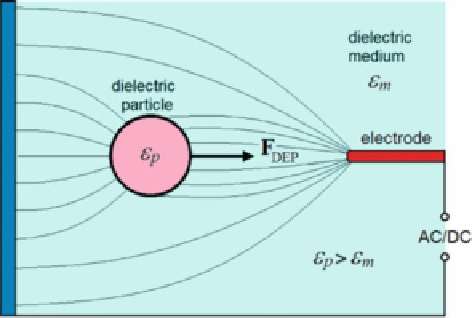Environmental Engineering Reference
In-Depth Information
14.2 Theoretical Considerations
14.2.1 Dielectrophoresis
The major electrical forces acting on small particles suspended in a fluid are due to
electrophoresis and dielectrophoresis phenomena. Electrophoresis occurs due to the
action of the electric field on the fixed, net charge of the particle, while dielectro-
phoresis only occurs when there are induced charges, and only results in motion in a
nonuniform field (this can be a DC or an AC field) (Fig.
14.5
).
Pohl [
10
] used this term to describe the force exerted on uncharged dielectric
particles by their polarizability, having the following main characteristics:
- Particles experience a DEP force only when the electric field is nonuniform.
- The DEP force does not depend on the polarity of the electric field and is
observed with AC as well as DC excitation.
- Particles are attracted to regions of stronger electric field when their permittivity
ε
p
exceeds that of suspension medium
ε
p
> ε
m
- Particles are repelled from regions of stronger electric field when
ε
m
, i.e., when
ε
p
< ε
m
The utilization of the difference between dielectrophoretic forces exerted on
different particles in nonuniform electric fields is known as DEP separation. The
exploitation of DEP forces has been classified into two groups: DEP migration and
DEP retention. DEP migration uses DEP forces that exert opposite signs of force on
different particle types to attract some of the particles and repel others [
35
]. DEP
retention uses the balance between DEP and fluid-flow forces. Particles experienc-
ing repulsive and weak attractive DEP forces are eluted by fluid flow, whereas
Fig. 14.5 Electrically neutral particle in the presence of a spatially nonuniform electric field. The
dipole moment induced within the particle results in a translational force and the dielectric
spherical particle undergoes a DEP motion. For AC bias voltage, the potential will be interchanged
periodically on the electrodes and the resulting force on the particle is still acting on the same
direction due to uneven electric field distribution

